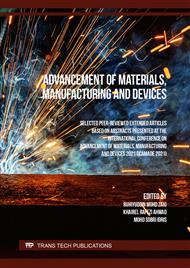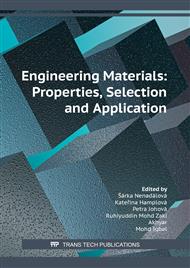[1]
T. Unander and H. E. Nilsson, Characterization of printed moisture sensors in packaging surveillance applications,, IEEE Sens. J., vol. 9, no. 8, p.922–928, (2009).
DOI: 10.1109/jsen.2009.2024866
Google Scholar
[2]
G. Cummins and M. P. Y. Desmulliez, Inkjet printing of conductive materials: A review,, Circuit World, vol. 38, no. 4, p.193–213, (2012).
DOI: 10.1108/03056121211280413
Google Scholar
[3]
E. H. Jewell, S. M. Hamblyn, T. C. Claypole, and D. T. Gethin, The impact of carbon content and mesh on the characteristics of screen printed conductive structures,, Circuit World, vol. 39, no. 1, p.13–21, (2013).
DOI: 10.1108/03056121311298918
Google Scholar
[4]
D. Li, W. Y. Lai, Y. Z. Zhang, and W. Huang, Printable Transparent Conductive Films for Flexible Electronics,, Adv. Mater., vol. 30, no. 10, p.1–24, (2018).
DOI: 10.1002/adma.201704738
Google Scholar
[5]
T. Agcayazi, K. Chatterjee, A. Bozkurt, and T. K. Ghosh, Flexible Interconnects for Electronic Textiles,, Adv. Mater. Technol., vol. 3, no. 10, p.1–32, (2018).
DOI: 10.1002/admt.201700277
Google Scholar
[6]
A. Al-Halhouli, H. Qitouqa, A. Alashqar, and J. Abu-Khalaf, Inkjet printing for the fabrication of flexible/stretchable wearable electronic devices and sensors,, Sens. Rev., vol. 38, no. 4, p.438–452, (2018).
DOI: 10.1108/sr-07-2017-0126
Google Scholar
[7]
J. M. Abu-Khalaf, L. Al-Ghussain, and A. Al-Halhouli, Fabrication of stretchable circuits on polydimethylsiloxane (PDMS) pre-stretched substrates by inkjet printing silver nanoparticles,, Materials (Basel)., vol. 11, no. 12, p.1–17, (2018).
DOI: 10.3390/ma11122377
Google Scholar
[8]
I. J. Fernandes et al., Silver nanoparticle conductive inks: synthesis, characterization, and fabrication of inkjet-printed flexible electrodes,, Sci. Rep., vol. 10, no. 1, p.1–11, (2020).
DOI: 10.1038/s41598-020-65698-3
Google Scholar
[9]
Y. J. Wan, G. Li, Y. M. Yao, X. L. Zeng, P. L. Zhu, and R. Sun, Recent advances in polymer-based electronic packaging materials,, Compos. Commun., vol. 19, no. November 2019, p.154–167, (2020).
DOI: 10.1016/j.coco.2020.03.011
Google Scholar
[10]
S. Mei et al., 3D-Printed thermoplastic polyurethane/graphene composite with porous segregated structure: Toward ultralow percolation threshold and great strain sensitivity,, J. Appl. Polym. Sci., vol. 138, no. 14, p.1–11, (2021).
DOI: 10.1002/app.50168
Google Scholar
[11]
H. Saad, M. A. Salim, N. Azmmi Masripan, A. M. Saad, and F. Dai, Nanoscale graphene nanoparticles conductive ink mechanical performance based on nanoindentation analysis,, Int. J. Nanoelectron. Mater., vol. 13, no. Special Issue ISSTE 2019, p.439–448, (2020).
Google Scholar
[12]
M. Mokhlis, A Study On Mechanical And Electrical Properties Of Hybridized Graphene-Carbon,, (2019).
Google Scholar
[13]
X. Chen, Novel technique for measuring the mechanical properties of porous materials by nanoindentation,, p.715–724, (2006).
Google Scholar
[14]
J. Gubicza, A. Juhász, P. Tasnádi, P. Arató, and G. Vörös, Determination of the hardness and elastic modulus from continuous Vickers indentation testing,, J. Mater. Sci., vol. 31, no. 12, p.3109–3114, (1996).
DOI: 10.1007/bf00354655
Google Scholar
[15]
I. A. Ovid'ko, Mechanical properties of graphene,, Graphene Sci. Handb. Mech. Chem. Prop., p.3–15, (2016).
Google Scholar
[16]
M. A. N. Dewapriya, A. Srikantha Phani, and R. K. N. D. Rajapakse, Influence of temperature and free edges on the mechanical properties of graphene,, Model. Simul. Mater. Sci. Eng., vol. 21, no. 6, (2013).
DOI: 10.1088/0965-0393/21/6/065017
Google Scholar
[17]
S. Chatterjee, F. Nafezarefi, N. H. Tai, L. Schlagenhauf, and F. A. Nu, Size and synergy effects of nanofiller hybrids including graphene nanoplatelets and carbon nanotubes in mechanical properties of epoxy composites,, vol. 0, p.1–7, (2012).
DOI: 10.1016/j.carbon.2012.07.021
Google Scholar
[18]
D. Kim and J. Moon, Highly conductive ink jet printed films of nanosilver particles for printable electronics,, Electrochem. Solid-State Lett., vol. 8, no. 11, p.30–33, (2005).
DOI: 10.1149/1.2073670
Google Scholar
[19]
M. Mokhlis et al., Nanoindentation of graphene reinforced epoxy resin as a conductive ink for microelectronic packaging application,, Int. J. Nanoelectron. Mater., vol. 13, no. Special Issue ISSTE 2019, p.407–418, (2020).
Google Scholar



